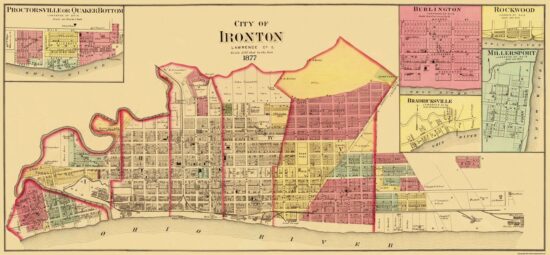|
BEFORE IRONTON, OHIO – THE BEGINNING Submitted by Martha J. Martin-Kounse
In 1848, the land along the Ohio river a few miles above Hanging Rock was almost a wilderness. There were a few scattered homes, small farms, and apple trees. The territory was well drained, there being two creeks, one named Storms which emptied into the river, and the other, Rachel, which paralleled the river for a mile, emptying into Storms near its mouth. This second creek was only about 800 feet north of the river, leaving a narrow strip of land between the creek and the river. Behind this creek was higher ground, which sloped from the high hill, a half mile away. Today, no one would select such a location as a site for a city, but little did our forefathers, who named Ironton as the river terminus for the Iron Railroad in 1849, think of streets, avenues, and alleys. Their thoughts were for a river wharf where that railroad could unload its cars of iron on boats and, in return, transport provisions back out into the hills to the furnaces which produced the Iron, At that time, within a radius of 13 miles back in the hills, rich in coal, timber, Iron ore, and limestone, were 13 busy furnaces. John Campbell dreamed of Ironton and helped build Keystone, Madison, Monroe, Howard, and Gallia furnaces. But closer was Amanda in Greenup County, Kentucky, built-in 1818. Union at Hanging Rock, built-in 1826; Franklin in 1827; Pine Grove in 1828; Junior in 1832; Buckhorn, Hecla, Mount Vernon, and Vesuvius, all built in 1833; Lawrence In 1834; LaGrange in 1836; Olive in 1846, and others. From 1818 until the time of the first World War, there had been erected in the Hanging Rock Iron Region, 87 pig iron furnaces, Just across Storms Creek (north approach of the overhead railway crossing on North Second street, (U. S. Route 52) was a little frame church where Rev. John Lee, a Baptist minister, held services. This was not in the first land purchase but was the first church to serve the people living in Ironton, early in 1849. Thus we have a description of what John Campbell and associates saw when they drove up the river bank from Hanging Rock to view a new town site. THE BEGINNING Gold was discovered in California on January 14, 1848, and men seeking riches the “easy way” were enduring hardships over land, mountain, and through the desert to reach the west coast, as our story begins. . . Men in Lawrence county worked with the pick, shovel, and ax, where timber for charcoal, coal and iron ore, and limestone were plentiful. A few men owned the furnaces, known as “Iron Masters.” These men were dreaming of transportation. . . . They wanted a railroad to replace the ox carts, a slow way of hauling the pig iron to the river for shipment. . . . Iron was the base which our nation needed to build new industry and railroads. A narrow gauge railroad was built from Hanging Rock to Newcastle In 1846… The owners of this three-mile railway were enthused about extending the line to connect with the county’s other prosperous pig iron furnaces, all seeking an outlet to move their pig iron to the Ohio river for shipment. Two leaders in this railway extension movement were Robert Hamilton and John Campbell, iron masters of wealth… When John Campbell went to Buffalo, N. Y., in the summer of 1848 to attend the national political convention which nominated Van Buren and Adams, who Zachary Taylor and Millard Fillmore defeated,. . certain actions were taken during his absence by the group of men promoting the new proposed railroad, which caused him to fall out with Mr. Hamilton, upon his return. Dr. Caleb Briggs, who at the time was doing a geological survey for the State of Ohio of the Hanging Rock-Ironton region, was taken into Mr. Campbell’s confidence and became his personal representative to help engineer a survey for another railroad. It was Dr. Brigg’s idea that the terminus of the proposed railroad was on the Ohio river, three miles east of Hanging Rock, which was higher ground and offered better grades to reach the furnace lands back in the hills from the river. , . . Two other men of means, James 0. Willard and John Peters were quick to accept the idea suggested by Dr, Briggs. and the mouth of Storms Creek was selected as the site for the new steam railroad,—Thus Ironton begins… |
You will not be able to cast a potent love spell. Effective spell to bring back a lover have a lot of magical energy. Spells to return love. z-library z-library zlib project


0 Comments